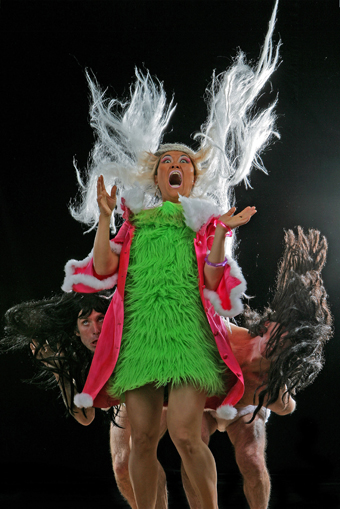 |
Matt Crosby, Yumi Umiumare, Ben Rogan, dasSHOKU Hora! photo Jeff Busby |
Umiumare’s most recent work extends the themes of previous pieces, Tokyo DasSHOKU Girl and DasSHOKU Cultivation. The first work saw the performer teaming with fellow artists Ben Rogan and Matt Crosby to unearth features of Japanese culture which appear curious or exotic to an Australian audience—from the relative innocence of karaoke to the bizarre eroticism of vending machines stocking schoolgirls’ underwear. Cultivation again featured Crosby along with Japanese performance ensemble Theatre Gumbo (themselves regular visitors to Melbourne), expanding upon the previous work’s intentions and delivering a new assortment of characters to unsettle preconceptions. DasSHOKU Hora! acts as a concentrated summation of the trilogy’s overall focus, specifically taking us on a rapid tour of the monstrous feminine, Japanese-style.
If the first 2 works in this series employed the cabaret form to allow a necessary diversity in characterisation, Hora! produces a more compelling way of connecting its various subjects. The central figure, Umiumare herself, metamorphoses incessantly through a garish array of forms. Each incarnation draws from the stock of Japanese stereotypes, be they figures of myth or reality. Indeed, Umiumare seems to consciously blur the boundary between folkloric trope and contemporary history, suggesting that the image of the giggling Japanese schoolgirl has as much (or as little) grounding in fact as the ancient cave-dwelling witch.
The set itself is amorphous, consisting of a raised walkway which snakes around the theatre, audiences seated at tables scattered along its flanks. In one corner of the space sits a jumble of boulders, and it is atop one of these that we first spy Umiumare. She emerges as the yamanba, the white-haired crone of the mountains, long wig falling over a shapeless shift dress as she descends, all jerky limbs and electric tension. Soon enough she gives birth to 2 primal males clad in oversized fluffy nappies and the knotted black hair of wildmen. It is in this extended sequence that we find the first instance of the sort of unsettling incongruities Umiumare is toying with—here a withered hag who also embodies a kind of perverse maternity. But despite the pun of the show’s title, there is as much glee in this bending of gender as there is horror (the traditional yamanba is often depicted with a grin that stretches from ear to ear).
The chaotic birth of this first sequence shifts to a more current setting as Umiumare becomes a ganguro girl, one of the teenagers who dress in outrageously high boots and short skirts and adorn themselves with wild accoutrements and gaudy makeup (white lips and eyeshadow offset by excessively deep tans). This is not a fanciful leap, as an extreme form of the ganguro style is itself sometimes termed yamanba, wherein young women imitate the ogress of the mountain. But in drawing this link, Umiumare offers us a way of reconsidering these feminine figures as instances of deliberate excess and grotesque identity, a masquerade which parodies expected notions of femaleness by taking them to the limit. The final character of Hora! is a PVC-clad Hello Kitty who lures a sleazy businessman into a pleasure chamber before forcing onto him a very messy and violent transformation.
Hora! received dramaturgical assistance from Moira Finucane, whose previous collaborations with Umiumare include the hugely successful The Burlesque Hour, and in some ways this work acts as an elegant dance partner to Finucane’s most recent solo outing, Gotharama (RT68, p46). Beyond the shock-horror settings each shares, there is a common sensibility which sees the artists producing a kind of inverted teratology, a study of the monstrous from within that category. Crosby and Rogan play mad scientists and sex-obsessed salarymen and we are never expected to identify with them, instead taking sides with the characters Umiumare presents who would conventionally occupy the space of the Other.
DasSHOKU Hora! never adds up to a coherent narrative and, at times, the sheer hysteria of the performers threatens to overwhelm its audience, but the cumulative effect is potent and exciting, allowing contradictory interpretations to collide and enhance one another. The mayhem may in fact be the meaning here, but in any case it is a frighteningly entertaining madness.
DasSHOKU Hora!, created and performed by Yumi Umiumare in collaboration with Matt Crosby and Ben Rogan, set design Mary Moore, dramaturgy Moira Finucane, costume design ESS.HOSHIKA LABORATORY, sound Tatsuyoshi Kawabata, lighting Dori Bicchierai; Tower Theatre, CUB Malthouse, Melbourne, Nov 2-13, 2005
RealTime issue #71 Feb-March 2006 pg. 7
© John Bailey; for permission to reproduce apply to [email protected]








 back
back